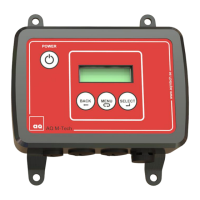AQ M-Tech AB Ultrasound Controller Manual 11
6. Air Sensor Mode
In Air Sensor mode the Air Sensor is used to measure the presence of bubbles in flowing liquid.
To one Ultrasound Controller there can be connected two Air Sensors model SAC, APS, DAP,
DAT, CCS, PAC, FCS or FCP. For Air Sensor model CQS only one can be connected.
Quick start guide
• Install Air Sensors according to instructions in the Air Sensor Manual.
• Connect cables, see page 7 or 8 and 12.
• Switch on external power supply.
• Read about navigating the menu system, page 9.
• If display show: SET sensor MODE. Choose Press SELECT for Air Sensor mode by scrolling with
MENU button and selecting with SELECT button.
• Go to SETTINGS see page 14 and set all parameter that need to be set.
• Fill Air Sensor 1 (AS1) with liquid. Select Calibrate LIQUID AS1 and Press SELECT button one
second.
• Empty Air Sensor 1 (AS1) of liquid. Select Calibrate AIR AS1 and press SELECT button one
second.
• Do the calibration in the same way for Air sensor 2 (AS2). The calibration can be done in any
order as long as both air and liquid will be calibrated.
• A simple validation: AIR should be indicated when the Air Sensor is empty and LIQUID when
it is filled with liquid.
• Go to SHOW DATA for a more thorough validation of the calibrated values, see page 16.
• Ready.
Functional Description
Bubbles in the liquid flowing through the Air Sensor are monitored using ultrasound. Inside the Air
Sensor two low intensity beams of ultrasound are transmitted across the liquid-path. When a
bubble moves through an ultrasound-beam the sound will be partially deflected and the intensity
of the ultrasound beam changes. The controller constantly measures ultrasound intensity and in
this way detects bubbles. Dense particles in the liquid can also deflect ultrasound and therefore
can cause bubble detection. Normally there are two ultrasound beams or four beams for Air
Sensor CQS. Using muliple beams allowes higher sensitivity and more reliable bubble detection.
The measurement when very low sensitivity is selected, uses a different measurement technique.
It measures ultrasound echoes in the air sensor walls being dampened by liquid. The sensitivity
for bubbles is very low. However there is a temperature dependency so it is good if temperature
during calibration and operation do not vary more than +-5ºC in this case.
The measurement accuracy depend on how well the Air Sensor is calibrated, the flow-rate, the
type of liquid, how the Air Sensor is mounted and weather there is a single bubble or many
bubbles and the Air Sensor size.
Orientation of the Air Sensor
If the Air Sensor is mounted horizontally orientation is important. Liquid flowing through the Air
Sensor tends to pull bubbles towards the center of the tube but when flow rate is low, bubbles can
rise to the top. The Air Sensor is slightly more sensitive to bubbles if it is rotated so that the
cable/connector is facing up.

